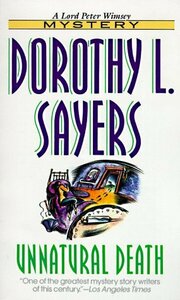Take a photo of a barcode or cover
This is a delightfully unusual mystery structure and the introduction of the excellent Miss Climpson, but I always forget that this is also the one where Dorothy Sayers uses the n-word A LOT because 1927. Oh, Dorothy Sayers, no.
Not my favorite Lord Peter Wimsey. Miss Climpson is the best part of the book
adventurous
mysterious
medium-paced
Extremely of it's time (astonishingly racist and homophobic) and less tightly plotted than a Christie but Peter does have more character development than Poirot or Miss Marple.
Not enamored with Why-Done-Its, or How-Done-Its in general, and thought this one laden with digression and silly characters. Always disappointed when I guess it.
My reactions to this book are all over the place. There were parts I really enjoyed and on the whole, I love the Lord Peter series. I ultimately could only rate it two stars because of the overt racism . Yes, I understand the book was written almost 100 years ago and times were different. However, reading numerous negative stereotypical portraits of black people was like hearing nails on a blackboard while listening to music. It ruins the enjoyment of the song you are listening to, making you cringe in discomfort instead.
After all, even blacks are God's creatures and we might all be black ourselves if He had not in His infinite kindness seen fit to favour us with white skin
This horrible blackamoor ROLLING his dreadful eyes at her
His black eyes, yellow about the whites and slightly protruding, rolled amiably at them
God bless my soul, an English girl in the hands of a n***er. How abominable!
The lesbians in the book were treated better, although there were still cringy comments about them as well. Of course, no one said out loud that the women were gay. They were just close friends who lived together and had crushes on each other. Uh...ok.
It is very delightful to be free from the conventions, I'm sure - especially if one is in company with a kindred spirit
I cannot help feeling that it is more natural for a man and a woman to be all in all to one another than for two persons of the same sex. After all, it is a fruitful affection
After all, even blacks are God's creatures and we might all be black ourselves if He had not in His infinite kindness seen fit to favour us with white skin
This horrible blackamoor ROLLING his dreadful eyes at her
His black eyes, yellow about the whites and slightly protruding, rolled amiably at them
God bless my soul, an English girl in the hands of a n***er. How abominable!
The lesbians in the book were treated better, although there were still cringy comments about them as well. Of course, no one said out loud that the women were gay. They were just close friends who lived together and had crushes on each other. Uh...ok.
It is very delightful to be free from the conventions, I'm sure - especially if one is in company with a kindred spirit
I cannot help feeling that it is more natural for a man and a woman to be all in all to one another than for two persons of the same sex. After all, it is a fruitful affection
funny
lighthearted
mysterious
fast-paced
Plot or Character Driven:
Plot
Strong character development:
Yes
Loveable characters:
Yes
Diverse cast of characters:
No
Flaws of characters a main focus:
No
.It started as an interesting book but the ending was too predictable. I still liked the scientific evidence solving in the early times.
I'm reading the Lord Peter Wimsey books in order, and I'm increasingly enchanted with them. I first began to notice the subtlety in Sayers' work with her first Lord Peter novel Whose Body?, where there was a quite unexpected and vivid depicton of shell-shock.
In Unnatural Death the mystery revolves not around a whodunnit, but around the why and the how of the murder. I imagine the method of death must have been a bit unusual for the 1930s, although of course we've seen it depicted over and over by now.
Throughout the book the ethics of the crime are questioned - is a murder such a bad thing if the victim was old, dying anyway, in terrible pain and her death would be of substantial benefit to her murderer? And is Lord Peter in some way responsible for the further deaths by not leaving well enough alone and thereby pushing the murderer over the edge? Sayers both raises and neatly answers these questions in a beautiful scene between Lord Peter and a Catholic priest. Lord Peter is a peculiarly vulnerable figure -- he is intelligent, wealthy and entitled, but also prey to moral fears and self doubt. He's full of quirks that are both endearing and frustrating to those around him. And though he will quite happily plot murders in his head as an intellectual exercise, his squeamishness over real death shows his humanity. My favourite scene was the last, where Lord Peter sat silently by the body of the murderer, while all the action carried on around him. Sayers never explicitly states what Lord Peter is feeling, but he does comment on what a dark day it is. In all three of her books so far, Sayers manages at the last moment to pull murder away from some intellectual exercise or literary endeavour and into the real world, where it is both savage and sad. Quite unusual for such a 'jolly' little murder mystery.
I also like her nuanced depictions of character. I was quite surprised to hear some people describe the book as racist. Characters in the novel do express racist attitudes that were common at the time, and these are shocking to modern ears, but this is a case of the views of the characters not reflecting those of the author. The book itself is, I feel, more complicated than that. The only negative portrayals of people of colour are the imaginary ones -- the 'gang' of either Jewish or black men who are supposed to have kidnapped one character and murdered another. In the end the racism is neatly turned on its head as it's shown to be a red herring. The murderer exploits the racist attitudes of others (and the sensationalism of the media) to her advantage, but she loses in the end, and these views are shown up for what they are. I can't help but feel Sayers' must have been been playing with the attitudes of her contemporary readers with this ploy.
The characters of course can't help expressing sexist views either, but I find these hilarious rather than bothersome. I think Sayers is a bit of a feminist underneath. I love the introduction of a middle-aged spinster as one of the investigators, and I wish we could see more of her but I'm rather afraid she might not appear in later books. It's all part of the texture of the books, and these are highly textured books, with a wealth of tiny details, imaginative touches and literary allusions. It's very easy to step into the world of Sayers, and a lot of fun too.
In Unnatural Death the mystery revolves not around a whodunnit, but around the why and the how of the murder. I imagine the method of death must have been a bit unusual for the 1930s, although of course we've seen it depicted over and over by now.
Throughout the book the ethics of the crime are questioned - is a murder such a bad thing if the victim was old, dying anyway, in terrible pain and her death would be of substantial benefit to her murderer? And is Lord Peter in some way responsible for the further deaths by not leaving well enough alone and thereby pushing the murderer over the edge? Sayers both raises and neatly answers these questions in a beautiful scene between Lord Peter and a Catholic priest. Lord Peter is a peculiarly vulnerable figure -- he is intelligent, wealthy and entitled, but also prey to moral fears and self doubt. He's full of quirks that are both endearing and frustrating to those around him. And though he will quite happily plot murders in his head as an intellectual exercise, his squeamishness over real death shows his humanity. My favourite scene was the last, where Lord Peter sat silently by the body of the murderer, while all the action carried on around him. Sayers never explicitly states what Lord Peter is feeling, but he does comment on what a dark day it is. In all three of her books so far, Sayers manages at the last moment to pull murder away from some intellectual exercise or literary endeavour and into the real world, where it is both savage and sad. Quite unusual for such a 'jolly' little murder mystery.
I also like her nuanced depictions of character. I was quite surprised to hear some people describe the book as racist. Characters in the novel do express racist attitudes that were common at the time, and these are shocking to modern ears, but this is a case of the views of the characters not reflecting those of the author. The book itself is, I feel, more complicated than that. The only negative portrayals of people of colour are the imaginary ones -- the 'gang' of either Jewish or black men who are supposed to have kidnapped one character and murdered another. In the end the racism is neatly turned on its head as it's shown to be a red herring. The murderer exploits the racist attitudes of others (and the sensationalism of the media) to her advantage, but she loses in the end, and these views are shown up for what they are. I can't help but feel Sayers' must have been been playing with the attitudes of her contemporary readers with this ploy.
The characters of course can't help expressing sexist views either, but I find these hilarious rather than bothersome. I think Sayers is a bit of a feminist underneath. I love the introduction of a middle-aged spinster as one of the investigators, and I wish we could see more of her but I'm rather afraid she might not appear in later books. It's all part of the texture of the books, and these are highly textured books, with a wealth of tiny details, imaginative touches and literary allusions. It's very easy to step into the world of Sayers, and a lot of fun too.
My YouTube review: https://youtu.be/UI5BNPOBF1o
Another entertaining mystery, although there's a chunk in the middle about genealogy and inheritance law that is tedious and should have been shortened.
Another entertaining mystery, although there's a chunk in the middle about genealogy and inheritance law that is tedious and should have been shortened.


